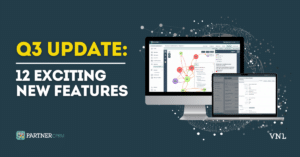
Organizational Network Analysis Questions: What Should You Ask Your Collaborators?
Getting started on an organizational network analysis? It’s not easy coming up with a plan on your own. A lot of people struggle coming up with organizational network analysis questions that will work for their goals. Our team has collectively spent decades conducting these analysis projects – we’ve gotten pretty good at creating insightful and meaningful organizational network analysis questions. Here are some major considerations to keep in mind as you draft your network survey.
Your Research Questions Should Drive Everything Else.
Your research questions should be your starting point: the broad questions about your network that you want to answer. There are countless potential questions, but you probably already have several in mind that have led you to consider an organizational network analysis. Here are a few examples of strong research questions:
- How has our network changed and developed over time?
- What is the strength of our community partnerships and inter-organizational relationships?
- How can be build more strategic networks to better reach our goals?
- How successful has our collaboration been at reaching shared goals?
- Who is working with who in our network, and how?
The best strategy is to select a handful of research questions at most. The more questions you attempt to answer, the longer your survey must be and the less responses you will collect. It’s better to target a few questions in-depth than try to answer a dozen very briefly.
Organizational Network Analysis Questions Also Depend On Context
Beyond your research question, the context of your organizational network analysis will determine what kinds of questions to ask in your survey. There are several different factors to consider. Here are just a few to get started with.
Inter Vs. Intra Organizational Network Analysis
It’s possible to analyze networks within a single organization, called intra-organizational network analysis, or networks across organizational boundaries, called inter-organizational network analysis. Measuring networks within a single organization requires a different way of thinking and different assumptions than an inter-organizational context, where people don’t share a common organizational membership and traditional hierarchies are less important. For example, you may be able to ask more questions for an intra-organizational analysis because workers are ordered to respond the survey by a CEO or other leader. This is not possible across organizations.
One In Time VS Longitudinal Analysis
A one-in-time study, also called a cross-sectional study, gives you a snapshot of how a network appears at a single point in time. Longitudinal studies collect data from partners at several points in time so you can track changes in responses over time. While a one-in-time study is easier and cheaper to conduct, the value of seeing your network change and tracking progress is invaluable in the long run. Longitudinal surveys often include questions designed to measure performance over time in areas of priority for improvement. For example, a network with limited trust can measure how relationships improve and strengthen in response to new efforts.
Focus on Impact & Evaluation Vs. Management & Strategy
Some organizational network analysis projects are required as a part of funding grants to determine the effectiveness of programs. Others are led by organizational leadership who want to adapt their strategy using a data-driven approach. These are often more forward-looking, while evaluation analysis projects look back to past performance, opinions on successes, and the ways people have worked together to reach them. Both types are most useful when their results are translated into actionable insights.

Our Validated Community Partner Survey has 19 Questions & Metrics
For those using organizational network analysis questions in an inter-organizational setting, we have a solution to save you time. We created our Validated Community PARTNER survey over the course of several years, using interviews and focus groups to better understand what matters most in a network of community partners. The result was a 19-question survey that includes our original, validated metrics for network trust and network value. This provides coalitions and collaboratives an easy way to create a survey that can be compared to thousands of other networks using. the exact same validated language.
More Resources for Organizational Network Analysis Questions
Still looking for more resources to help with your organizational network analysis project? Here are a few additional tools to help you get started:
- Blog: Who Should I Send My Network Survey To?
- Blog: Creating a Bias-Free Network Analysis Survey
- Blog: 10 Tips for Launching a PARTNER Network Analysis Survey
- Blog: 8 Tips for Designing a PARTNER Network Analysis Survey
- Infographic: How to Measure Trust in a Network
- Blog: An Intro to PARTNER’s Validated Metrics & Measures
Get Started on Your Own Organizational Network Analysis.
With a better understanding of your options for organizational network analysis questions, it’s time to start designing your own survey. If you’re still in need of help coming up with your questions, consider reaching out to our evaluation and consulting team for help. We’ve worked with hundreds of organizations to help them design their projects, collect data, analyze their results and produce reports with the important takeaways. We’d be happy to learn more about your needs and see how we can support you.

About the Author: Alex Derr, M.P.A.
Director of Marketing & Communications
Alex joined VNL in 2017, originally supporting our events. He now helps manages our communications and marketing strategy and content development work. Alex creates blogs, infographics, reports, and other content while managing our web and social media presence. He also runs our email marketing campaigns, tracks analytics, and conducts market research to drive our strategy. He supports our entire team with copywriting, graphic design and research, and helps with events, webinars, demos, and other online learning. When he isn’t at work Alex spends his time climbing 14ers (30 done, 28 to go!) and blogging on his own website, The Next Summit Blog.




